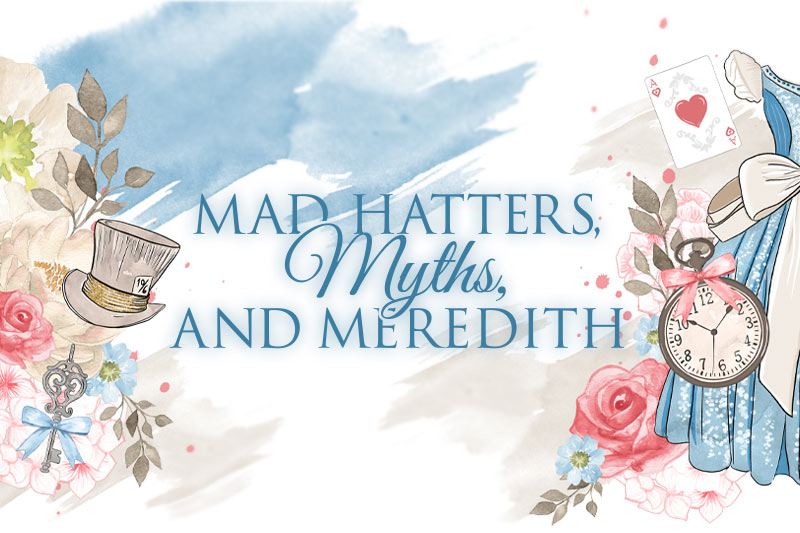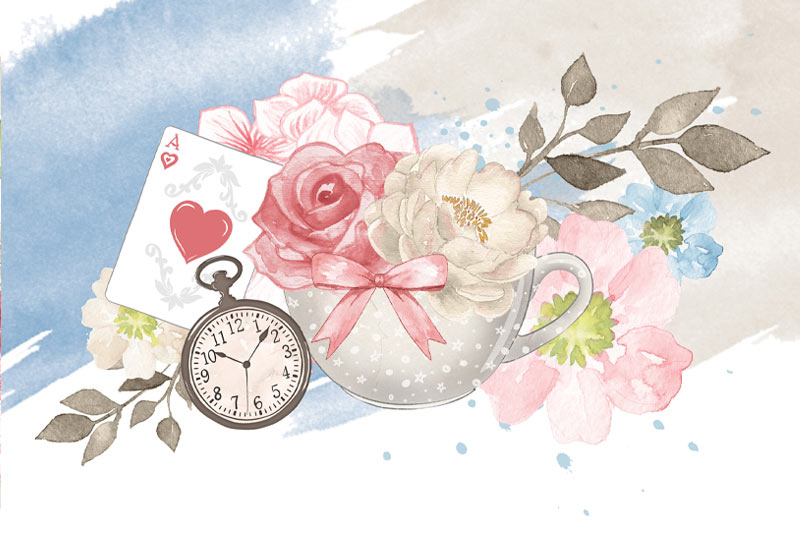
Mad Hatters, Myths, and Meredith
A Behind-the-Scenes Look at 100 Years of Alice in Wonderland
By Betsy Rhame-Minor, ’01
Mad Hatters, Myths, and Meredith
A Behind-the-Scenes Look at 100 Years of Alice in Wonderland
By Betsy Rhame-Minor, ’01
A Cheshire cat, a caterpillar smoking on a mushroom, a mad tea party, clever wordplay, and a little girl who navigates this strange world. To some, these bring to mind a childhood story and film adaptations. To those in the Meredith community, these mean much more.
Last month, Meredith College administration, faculty, and staff celebrated 100 years of Alice in Wonderland, with its 26th quadrennial production. Designed to be seen once in a student’s college years, the play also beckons alumnae back to campus to experience this unique gift from College employees to its students. Though the tradition occurs once every four years, it’s made a big enough impact that those in the Meredith community sometimes refer to the College as simply “Wonderland.”
“Everyone remembers seeing Alice,” said Carolyn Carter, ’73, who first saw the performance during her junior year in 1972. “I remember [it] vividly. We just knew it was something very special. Everyone was whispering and figuring out who were various characters.”
Said Anne Bromby, ’71, “I was a freshman so I really didn’t know many of the professors. I sat there for two hours in fantasy land knowing I was seeing something really special.”
Rumors and Myths
A popular story is that Meredith College’s Alice in Wonderland production began during
a flu epidemic and quarantine in 1924.
“The flu epidemic may not be true,” said Alice cast member and Director of Alumnae Relations Hilary Allen, ’01. “I think it was started around Valentine’s Day as a Valentine to the students.”
Betty Webb, professor emerita, Wings outreach director, and former Alice cast member, has also heard this explanation.
“The notion that this was a faculty gift to students during a flu outbreak is such a good story that it attracted Meredith students into believing it,” said Webb.
Jean Jackson, ’75, vice president for college programs, professor of English, and cast member and director of Alice, set out to solve this mystery and find the true origin of this tradition. The flu quarantine, she determined, is an urban myth. After extensive research in the College newspaper around the time of the first Alice production and even North Carolina state health records from 1924, Jackson says there is no evidence that this flu rumor is true.
Also, Jackson says, based on our own more recent experience with a pandemic, inviting sick or exposed people to gather for a play is illogical.
What she has learned, however, is that its origins were mysterious. Faculty managed to rehearse a script and create props without the student body’s knowledge. Students were invited to an evening reception, where faculty gave the surprise performance.
Bromby discovered a tiny, tattered script in the Library’s Alice archives, a play in three acts written for children, and that script is still very close to what is used today. Jackson supposes that someone had a copy of the script and the idea to perform it for students in 1924.
According to the College Archives, the first production of Alice was the idea of Director of Physical Education Gertrude Royster Sorrell, and Art Professor Ida Poteat created the first costumes.
Jackson likes to think of those first professors who were responsible.
“I don’t think there’s a way we can know their motivation fully,” she said. “I think the doing of it is noble enough. It’s lasted for 100 years, that says it works at Meredith and works for Meredith. I am so grateful to those early people who started this tradition. I’m sure they would be stunned to know it continues.”
Consistency and Change
In 100 years and 26 productions, some things change each production, and some things remain constant. The characters remain the same though the number of cards, flowers, and fairies can vary. While most of the script remains constant with each production, a few current cultural references are added.
One aspect that is largely the same, time after time, is the costumes. Painstakingly created and repaired by retired Dean of the School of the Arts Becky Bailey since the 1980s, some costumes have lasted decades.
“I imagine I volunteered [to help],” said Bailey, who studied visual arts and theater costume for her Ph.D. “It was a logical fit with my background.”
Her first task was making the new Humpty Dumpty, which was the original costume and about 60 years old. Bailey has constructed new costumes to be sturdier than the original ones.
“As casting has changed … things have changed in terms of how they’re costumed. The roles in general have become much more active in the time I’ve been involved,” she said.
Bailey has also standardized the makeup for each character or group of characters. The deck of cards all have the suit of their card painted on their faces. The flowers, she says, put on large false eyelashes and rosy cheeks and lips.
Costumes are just one of the many details that must be sorted out. Said Allen, “Seeing it from the other side, I don’t think people realize all that goes in it.”
For instance, the title character Alice starts practicing her lines in the fall, listening to the full script on her commute to and from campus. Main characters tend to hold the same parts sometimes for decades, and they also begin reviewing their lines early. Costumes and scenery are unearthed from their hiding places all over campus. Sometimes a new prop needs to be ordered or made.
“There are hundreds of details that have to be managed,” explained Jackson.
Casting Characters
Casting the roles when one opens up falls to Jackson, who has directed the play since 1992.
“Some of being the director is knowing the campus well enough to know who could do the parts,” she explained.
For instance, Jackson jokingly asked Vice President for Business and Finance Tammi Jackson in her job interview if she could roller skate. When Laura Davidson was hired to be Dean of Library Information Services, she learned that one of her job responsibilities would include storing costumes. Jackson has created spots in the script for faculty and staff members to show off hidden talents like belly dancing, tap dancing, and the tango.
“I think [Dr. Jackson] has seen potential in people that they have not seen in themselves,” said Bailey. “It’s just another little quirk in our 100-year history.”
Familiar Faces
For the students, seeing faculty and staff they recognize in comical roles is what makes this tradition so special.
“You hear about it and you finally get to experience it,” said Katie Perkins O’Neill, ’09, who saw Alice for the first time in 2008 and hasn’t missed a performance since. “There will be some surprises. You never knew what professor you would see. … You can’t see [the White Rabbit] and not think of Dr. Huber anymore, and Dr. Tippett as Queen. There’s nothing like hearing Dr. Lynch play the organ at the beginning. … It’s just so meaningful.”
Said Webb, “The delight of it is recognizing your serious, no-nonsense faculty members acting astonishingly bizarrely on stage.”
The actors appear to have as much fun as the audience.
“I tell every production the students won’t know if you miss a line,” said Jackson. “If you’re having fun they’re having fun seeing it. … Students want to have plenty to laugh at. They want to enjoy it in every way and be surprised by what their faculty and staff do for them.”
Besides the fun, there is deep dedication for those who play the same roles time after time.
Said Webb, “I [once] came back from a sabbatical in order to keep [my] role.” Jackson, who had two different roles in the play before assuming the director’s role and creating a new character, remembers hearing the news that she’d been named the production’s leader.
“…My colleague in Joyner, now Lux, elbowed me and said, ‘That’s better than tenure,’” Jackson said.
Said Allen, “[Faculty] love the community and want to do [Alice] as a gift for their students. It’s incredible. … I don’t think it would happen at any other school, and if it did it wouldn’t happen consistently for 100 years.”
In celebration of 100 years of the Alice in Wonderland production at Meredith College, two alumnae are producing a book that will soon be available to the Meredith community.
In January 2023, Anne Bromby, ’71, had the idea to highlight the 100 years and 26 productions.
“I did some research in the library and felt like we had enough to write a book,” Bromby said.
A few months later, Carolyn Carter, ’73, joined her, and they began enlisting the help of others. Thirty-four others, to be exact. Notable College administrators, faculty, staff, and alumnae are writing chapters for the book, designing the cover, creating the book design and layout, and collecting photos, memorabilia, and previous campus newspaper articles from Alice productions over the years.
“It’s a community effort for sure,” explained Bromby. “It’s really been lovely to see everyone embrace this little project and give it life.”
The book, Alice and Wonderland at Meredith College: The First 100 Years, will be available this spring at the Meredith College Campus Store in person and online. Proceeds from the sale of the book will support future Alice productions.
“We wanted to include the 100th celebration performance so the book … will be able to be a graduation gift and available at Reunion Weekend,” Bromby said.

